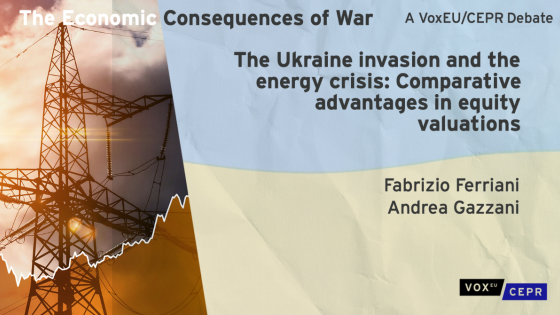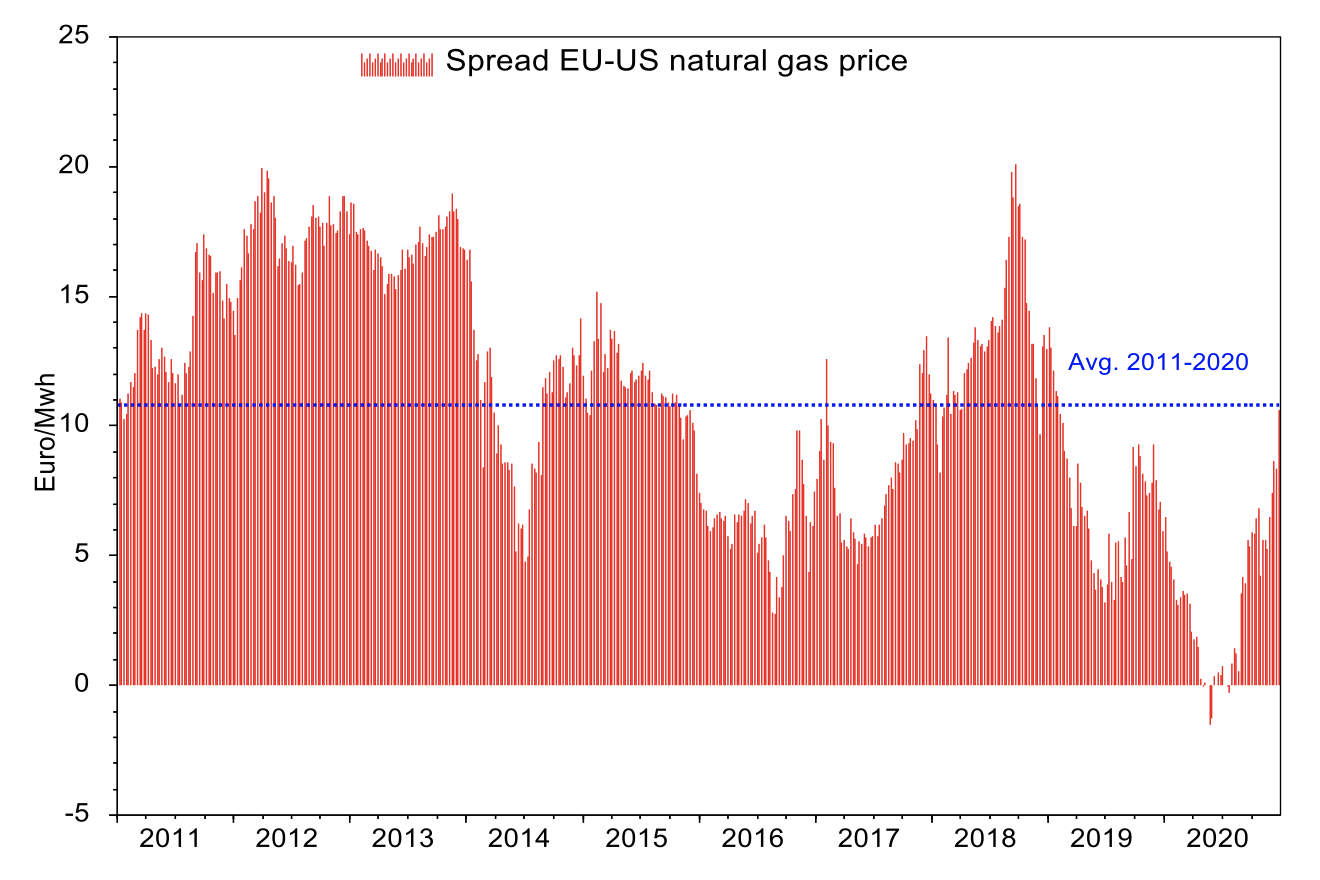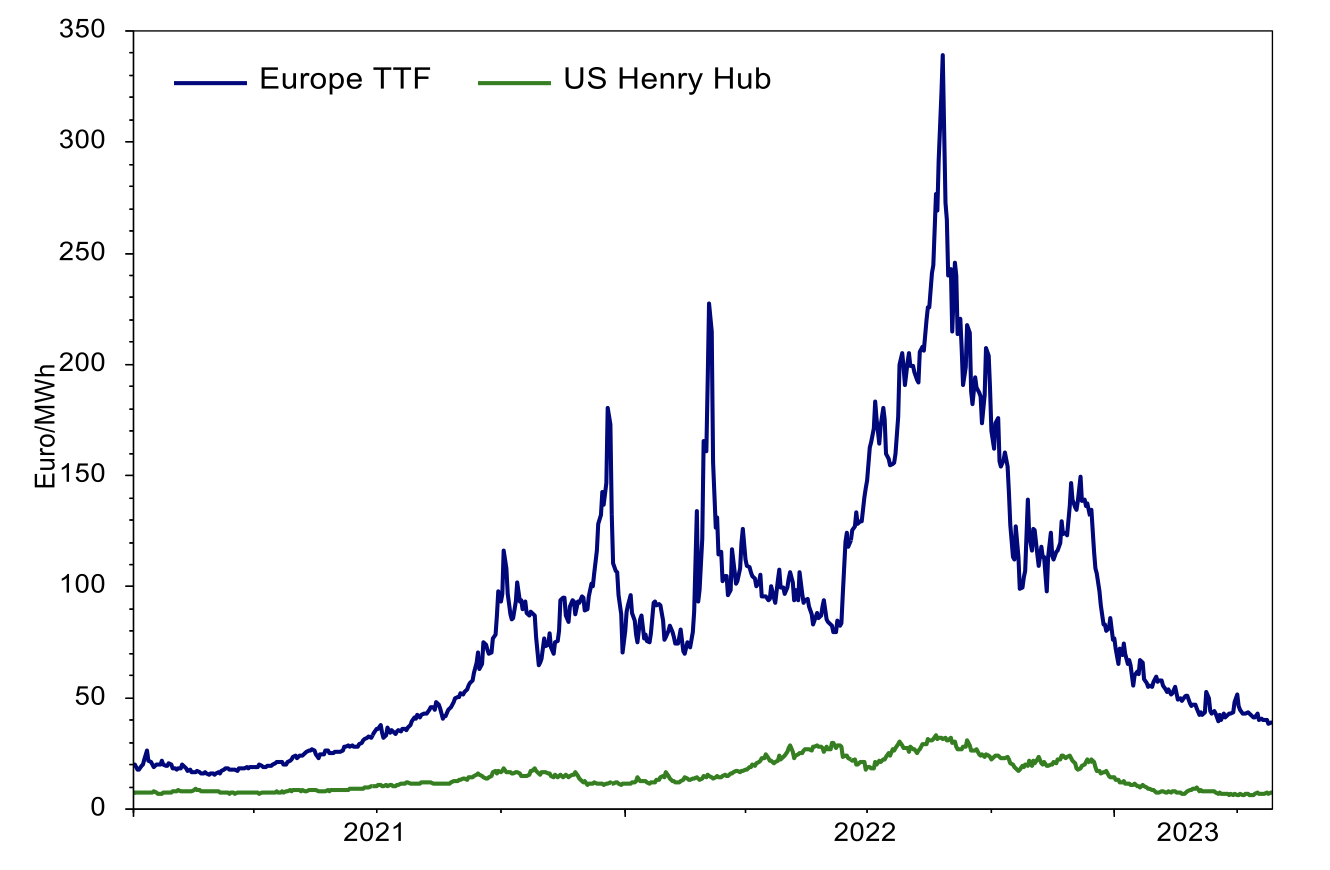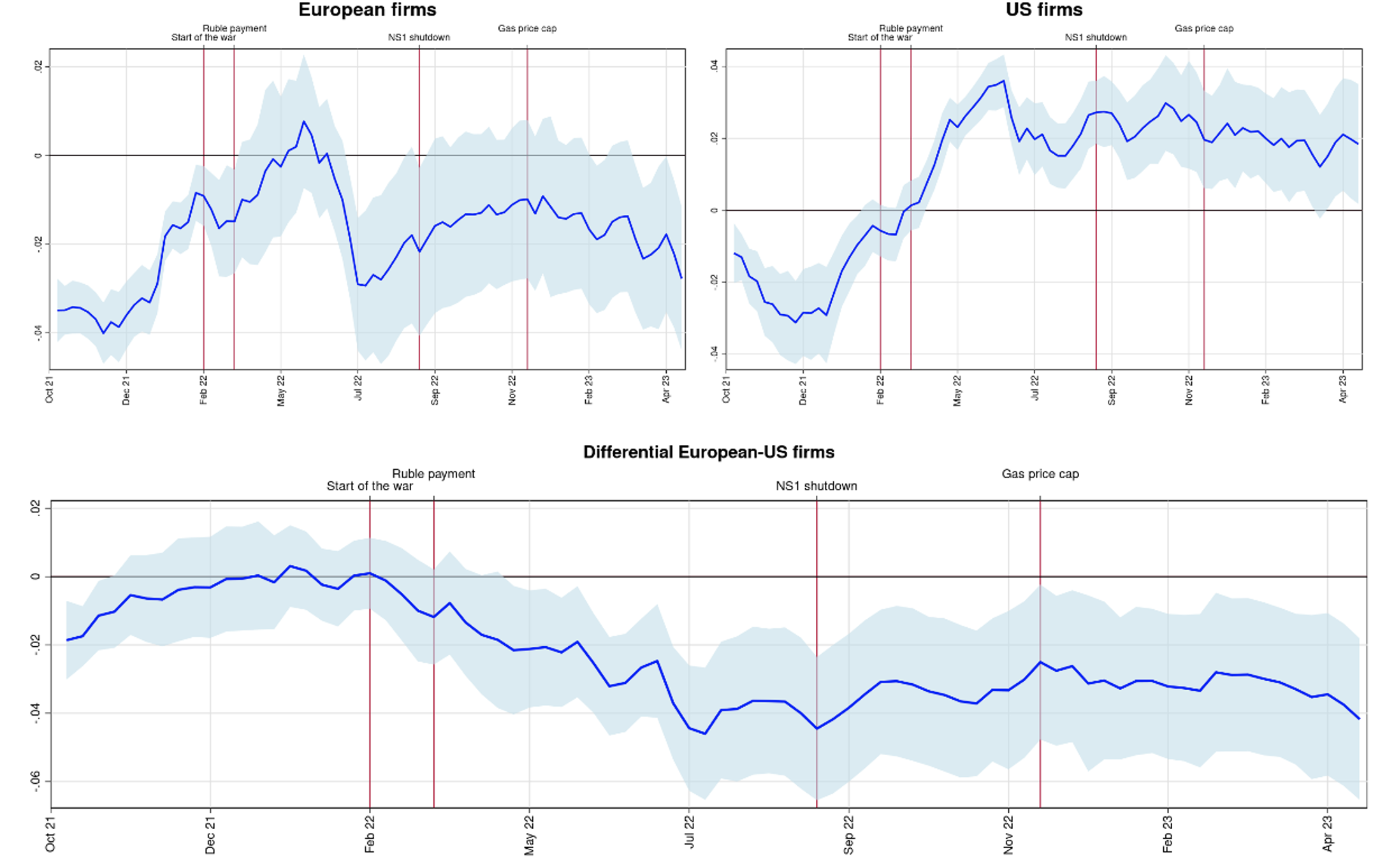One of the most abrupt consequences of the war in Ukraine, secondary to the dramatic loss of human lives and the massive devastation of the country, was the outburst of a major energy crisis. Developments in the energy market had global reverberations, but were particularly acute in Europe due to its heavy dependence on energy imports from Russia.
Due to the limited fossil energy production, energy prices in Europe (EU, hereafter for simplicity) have historically been higher than in other parts of the world, with direct implications for the overall competitiveness of European firms (European Commission 2023). The conflict in Ukraine has further exacerbated comparative disadvantages related to energy costs, in particular in the natural gas market, which experienced significant strain throughout 2022 due to the Russian weaponisation of natural gas exports as a retaliatory measure against Western sanctions. Figure 1 compares EU natural gas prices with those in the US, where the advent of the shale revolution led the US to switch its status from energy importer to exporter and ensured access to relatively cheaper energy inputs (Arezki et al. 2017). Between 2011 and 2020, EU natural gas prices consistently exceeded those in the US, averaging around €11/MWh; the differential between the two regions dramatically widened after the start of the conflict, reaching an average of about €207/MWh at the peak of tensions in the European energy market in August 2022.
Figure 1 Energy price differentials between Europe and the US
A) Spread between EU and US natural gas prices, 2011-2020
B) Spread between EU and US natural gas prices, 2021-2023
Note: The left plot displays the spread between EU and US natural gas prices during the period 01/01/2011-31/12/2020, the right plot displays EU and US natural gas prices during the period 01/01/2021-30/04/2023. Data are obtained from Refinitiv and refer to the TTF natural gas price (benchmark for Europe) and to the Henry Hub natural gas price (benchmark for the US, converted in Euro/MWh).
Comparative advantages in equity valuations
In a recent study (Ferriani and Gazzani 2023b), we examine firms’ equity prices to investigate how the heterogeneous exposure to the energy shock across different geographic regions has led investors to reassess stock valuations, thus providing insights into comparative advantages associated with energy costs. To this purpose, we conduct a comparative analysis between European firms, which faced substantial pressure in the energy market due to the war, and firms in the US, extending our previous work on the European stock market (Ferriani and Gazzani 2023a) to an international context.
We measure firms’ exposure to the energy shock as energy expenditures normalised by a proxy of firm size (market capitalisation or total revenues) or, alternatively, by firms’ operating costs to measure the incidence of energy inputs over total corporate expenditure. Additionally, we also proxy the sensitivity to the energy shock by using carbon emissions scaled by equity market value to capture firms’ exposure to climate transition risk in addition to their energy consumption (Bolton and Kacperczyk 2021). We estimate how firms’ energy exposure has affected equity returns in EU and the US between October 2021 - when the European TTF benchmark surpassed €100 /MWh for the first time - and April 2023, at the end of the winter season.
On average, we find that firms’ energy exposure has had a negative effect on equity returns in Europe: a one standard deviation increase in energy exposure is associated with a 0.9 percentage point reduction in European firms’ returns. Conversely, the same relationship is positive in the US: the coefficient indicates a positive effect of 0.7 percentage points on firm returns, implying a differential of 1.6 percentage points between the two areas. Figure 2 displays our estimates by means of a weekly time-varying estimation to provide a dynamic overview of how the EU-US return differential evolved accordingly to the major episodes characterising the European energy crisis. The weekly estimates of the energy exposure - returns relationship was negative in both Europe and the US before the invasion of Ukraine, but since February 2022 a divergence between the two areas emerged. In EU, the effect remained persistently negative throughout the remainder of the sample, while in the US it turned positive. Our results suggest that the lower energy costs faced by US firms, combined with the risk of energy rationing for European firms, have materialised in corporate asset prices, channelled via the extent of energy use in firms’ production functions. Interestingly, even after the inclusion of the European price cap and the partial subsiding of the energy price shock at the end of the 2022/2023 winter, the return differentials did not return to zero (it was around four percentage points at the end of April 2023), suggesting that investors believe the EU comparative disadvantage to persist over time. Our results are consistent across all our measures of energy exposure and are obtained by taking into account several firms’ characteristics as well as sector heterogeneity.
Figure 2 Equity returns and energy exposure, time-varying evidence
Note: The graph dynamically displays the impact of energy exposure (proxied by energy expenditures over market capitalisation) on cumulated daily equity return over the period 05/10/2021-30/04/2023. The left plot in the upper panel shows the evolution of the regression coefficient for EU firms, whereas the right plot shows the corresponding estimates for US firms. The lower panel plots the differential impact of energy exposures between EU and US firms.
Conclusions and policy implications
In Europe, the adverse impacts of the energy crisis induced by the war in Ukraine have been somewhat mitigated through a combination of factors, including favourable weather conditions, a major reshuffling of global energy flows, targeted policy measures aimed at enhancing energy security, and promoting energy conservation. Nevertheless, uncertainties regarding natural gas price dynamics in the upcoming winter seasons of 2023/24 persist. Factors such as adverse weather conditions, reduced availability of liquefied natural gas (LNG) for the European market due to increased competition from Asia, or a complete interruption of Russian gas deliveries (mainly via LNG) could reignite market tensions (International Energy Agency 2023). Our findings are consistent with this scenario, as we document that EU-US equity return differentials did not materially narrow even when energy tensions partially diminished.
In the absence of substantial progress in energy efficiency and the transition to a low-carbon economy, the enduring disparities in energy input costs have the potential to undermine European competitiveness (ECB 2023) and may prompt the relocation of production in search of more affordable energy prices, particularly in energy-intensive industries (Bialek et al. 2023). Furthermore, the lack of a coordinated EU energy policy and of harmonised support schemes for large energy consumers can exacerbate these challenges (Faiella and Mistretta 2020, González and Alonso 2021), potentially leading to an uneven distribution of energy-related competitive concerns within the EU bloc. With energy prices projected to stay above historical levels for the foreseeable future, policymakers are challenged to implement continued and coordinated policy actions aimed at addressing industrial subsidies, promoting energy efficiency, ensuring solidarity and energy security through cross-border energy flows, and pursuing investments in renewable energy sources to achieve sustainable long-term energy independence (Sgaravatti et al. 2023).
References
Arezki, R, T Fetzer and F Pisch (2017), “On the comparative advantage of US manufacturing: evidence from the shale gas revolution”, Journal of International Economics 107: 34–59.
Bialek, S, C Schaffranka and M Schnitzer (2023), “The energy crisis and the German manufacturing sector: Structural change but no broad deindustrialisation to be expected”, VoxEU.org, 17 January.
Bolton, P and M Kacperczyk (2021), “Do investors care about carbon risk?”, Journal of Financial Economics 142(2): 517–549.
ECB (2023), “The energy shock, price competitiveness and euro area export performance”, Economic Bulletin Issue 3/2023.
European Commission (2023), “Long-term competitiveness of the EU: looking beyond 2030”.
Faiella, I and A Mistretta (2020), “Energy costs and competitiveness in Europe”, Bank of Italy Working Paper No, 1259.
Ferriani, F and A Gazzani (2023a), “The impact of the war in Ukraine on energy prices: Consequences for firms’ financial performance”, International Economics 174: 221-230.
Ferriani, F and A Gazzani (2023b), “The Ukraine invasion and the energy crisis: comparative advantages in equity valuations”, Working Paper.
González, J S and C A Alonso (2021), “Industrial electricity prices in Spain: A discussion in the context of the European internal energy market”, Energy Policy 148, 111930.
International Energy Agency (2023), Gas Market Report Q2-2023.
Sgaravatti, G, S Tagliapietra and G Zachmann (2023), “Adjusting to the energy shock: the right policies for European industry”, Bruegel Policy Brief 11/2023.






